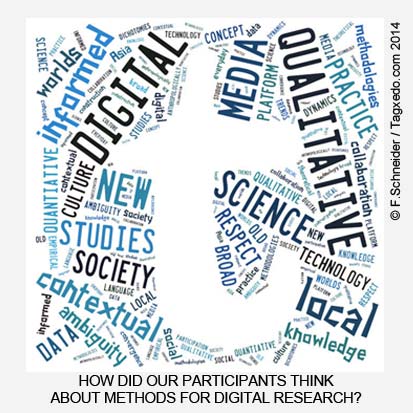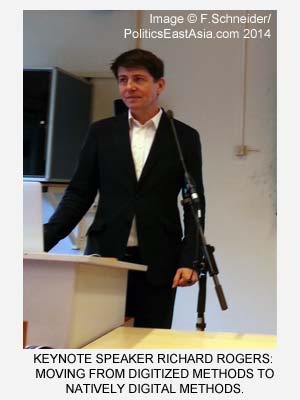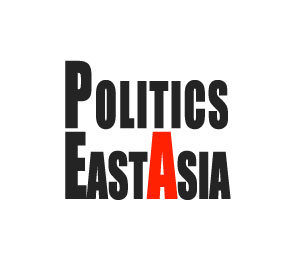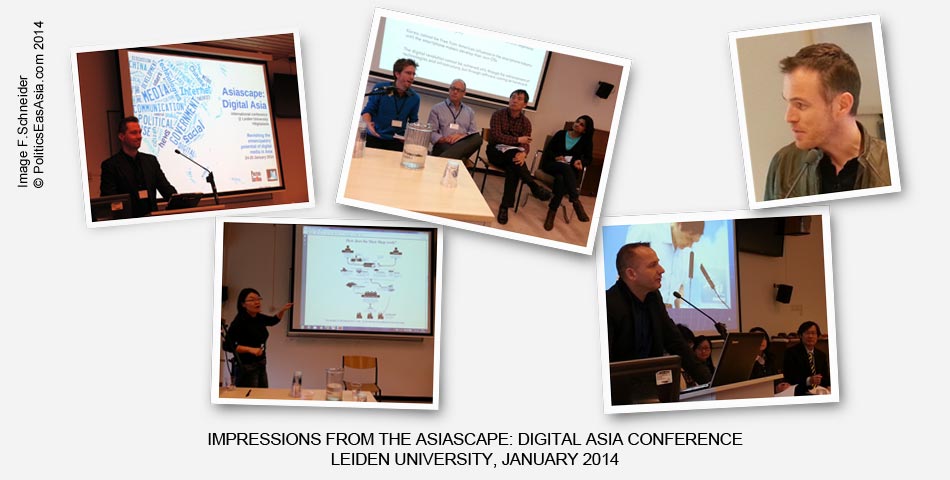The Digital Turn in Asian Studies
Review of the Asiascape: Digital Asia conference 2014
Like any interdisciplinary endeavour, studying digital communication in Asia can be challenging: not only does such work have to convince area specialists, it also has to connect with research across different disciplines, such as anthropology, economics, political science, media studies, or the computer sciences. About a year ago, several of my colleagues and I discussed how we could create a platform for those who are taking on that challenge. We decided that we needed a new academic journal, and that the work that we would showcase there should also be accompanied by events and discussions, both online and offline. As a result, we are launching the first issue of our new journal Asiascape: Digital Asia this March, and in the run-up to that launch we organized an international conference at Leiden University to discuss what it means to be part of the digital turn in Asian studies.
From the 24th to 25th of January 2014, we asked participants to help us revisit the debates surrounding digital media and their potential to emancipate people. Throughout five panels and three sessions of lively plenary discussion, our contributors presented empirical evidence from societies in Asia and debated the theoretical and practical implications of how digital media are used in diverse settings, ranging from China to Korea, from India to Indonesia. Some of their articles are available in the launch issue of our journal.
Rather than going chronologically through our conference programme, which is available online along with the book of abstracts, I want to take this opportunity to highlight what issues we came across in our discussions and suggest how our work on “digital Asia” might fruitfully proceed. Before the conference, we asked our guests to send us answers to three short questions about digital media and Asia, and much of our discussion revolved around the responses to these questions: where might we find “digital Asia”, how should we study our subject, and who might benefit from digital media’s supposed “emancipatory potentials”. I’ll go through each of these questions in turn. Throughout, I’ll also include examples from the conference, links to various useful resources, as well as reference to related books and articles. If you have additional ideas or materials to share, feel free to leave a note in the comment section below.
Where is digital Asia?
[grid_6] [frame_left]What our participants said:
“in life and society almost everywhere in Asia”
“Digital Asia is global, just as the many populations and individuals identifying as Asian can themselves now be found in locations across the globe”
“on a mixed terrain along a spectrum of infrastructures and user skill levels”
“Digital Asia is Asia in transformation – politically, socially, culturally, and also legally – by its digital media”
“it lies in a combination of the highly local, specific, and personal, and the broad and universal. Thus it can transcend traditional barriers of nation and state”
“Digital Asia is both online and offline, including both digital technologies’ effects on Asia and Asia’s effects on digital technologies”
“I would like to take ‘digital Asia’ as Asia itself, for the digital technology is increasingly becoming an integrated part of everyday life in Asia”
[/frame_left] [/grid_6]The first question we asked our participants was what the subject of our study really was. Does it make sense to talk about such a thing as “digital Asia”, and if so: where should we look for it? This is not simply a question of where Asia might be on a map (though google apparently places “digital Asia” alternatively in Singapore or in Chandigarh, India). What counts as “Asia” is a matter of complicated identity politics and knowledge construction, often closely linked to assumptions about the differences between “East” and “West”.
Studying digital Asia therefore also means critically questioning to what extent our work might be caught in Orientalist fantasies of hyper-dynamic Asian techno utopias. As one of our participants rightly pointed out, we should also ask “when is digital Asia” – not only because it is our responsibility to rethink the commonplaces about the “Asian century” that have become popular with businesses, international organizations, and governments, but also to check at what point in time we should roughly start looking for the “digital” in different Asian contexts.
We should remind ourselves that the ubiquity of digital media did not simply happen, but that it was created and promoted by policy-makers, entrepreneurs, programmers, journalists, and intellectuals, all engaged in the complex processes that are now commonly called “globalization” (Held & McGrew 2000). As Jonathan Benney pointed out in his talk on the design choices that went into creating the microblogging platform Sina Weibo, digital technologies are not necessarily value-neutral tools, but are often created by elites to serve certain purposes. In that sense, we’d be well advised to re-examine our own academic concepts, such the “information age” or the “network society” (Castells 2009, 2010), and carefully consider how they are used in utopian digital discourses that primarily benefit the social strata that Hoofd (2008, 2012) has called “speed elites” (see also Virilio 1977/2006).
But asking where digital Asia might be is also a practical question. Most of us are trained and employed to study a particular Asian country, so it may seem only prudent to use our expertise to study digital communication in, for instance, Japan, or Vietnam, or Malaysia. However, if digital technologies truly allow communication to transgress borders, then our studies will need to follow these information flows to look for “digital Asia” outside of the geographical confines of specific Asian countries. How people around the world produce, exchange, or use digital media from Asia deserves our attention just as much as how digital media “travel” transnationally within the Asian region and beyond. In either case, it might be worth heading Ulrich Beck’s (2005) warning to not fall into the trap of “methodological nationalism”: a view that assumes processes play out at a national level simply because so much of the data we use is produced by nation-state governments.
At the same time, there can be analytical reasons for studying digital media in a particular nation-state: language barriers, technological realities, and policy choices have each played their part in creating communication networks that are often far more national than they are cosmopolitan. One of the opportunities of the “locative turn” in media studies is to examine where the agents of digital communication really are, and to what extent “digital Asia” overlaps with the geographical borders of a set of nation-states.
How should we study digital Asia?
 Many of the concerns discussed above connect to other important questions: how should we analyse the object of our studies? What counts as data on “digital Asia”? What methods should we use? Not too surprisingly, the methodological approaches of our participants varied as widely as their subjects. For scholars interested in digital media content, methods might include discourse analysis, visual communication analysis, iconography, and various tools adopted from the study of literature, art, and culture. This was eloquently demonstrated by Patrick Sharbough, who studies how memes are deployed in Vietnam to criticize contemporary politics, or by Carl Li and Mari Nakamura, whose research in the Beyond Utopia project explores how manga or anime contribute to political thought in Japan.
Many of the concerns discussed above connect to other important questions: how should we analyse the object of our studies? What counts as data on “digital Asia”? What methods should we use? Not too surprisingly, the methodological approaches of our participants varied as widely as their subjects. For scholars interested in digital media content, methods might include discourse analysis, visual communication analysis, iconography, and various tools adopted from the study of literature, art, and culture. This was eloquently demonstrated by Patrick Sharbough, who studies how memes are deployed in Vietnam to criticize contemporary politics, or by Carl Li and Mari Nakamura, whose research in the Beyond Utopia project explores how manga or anime contribute to political thought in Japan.
For those who are interested in how digital cultural industries work, a combination of content analysis and political economy tools may be most helpful, as was clear in Ross Tapsell’s discussion of media freedom and converging media in Indonesia, in Dal Yong Jin’s work on the international appeal of Korean technology and digital culture, or in Ku Shu-shiun’s study of Taiwan’s digital creative industries. Yet other studies focus on the use of digital technologies in people’s everyday lives – a question that lends itself to participant observation, process tracing, and other ethnographic methods (Miller & Slater 2000). That such approaches can be highly fruitful was apparent from Nimmi Rangaswamy and Payal Arora’s insightful study of how teenage boys in Indian slums use cheap mobile phones and simple image editing software to woe potential romantic partners far above them in India’s social hierarchies. And then there are political scientists and political communication scholars, whose methodologies range from quantitative studies of social media posts to interviews with government officials or the analysis of policy documents.
What these and the other fascinating contributions to the Asiascape: Digital Asia conference demonstrate, is that distinctions between “offline” and “online” communication can be dangerously misleading: the cases our participants have been working on show that the digital is often an extension of the non-digital. While the massive popularity of digital media and communication can indeed be interpreted as a sea change in how our societies work today – for better (Shirky 2010) or worse (Morozov 2011) – the ways in which politics, society, and culture shape human communication processes (and are in turn shaped by them) are not always novel and revolutionary.
 Yet where these processes do have a novel dimension, the question remains how we should study that dimension. This was the subject of Richard Rogers’ keynote speech on how we can deploy digital methods to study digital communication in its own right – a question that is becoming central to the digital turn in the arts, humanities, and social sciences (see also Rogers 2013). Much of that digital turn has consisted of digitizing existing data or traditional research methods, for instance by creating digital archives and then conducting corpus analyses on the contents, or by gathering information through online surveys and questionnaires. As interesting as such “virtual methods” are (Hine 2005), it can also be useful to follow the medium and study what its “natively digital” elements tell us about our subject. Does linking behaviour between websites tell us anything about the politics of online association? How do Wikipedia entries in different languages construct different narratives on the same event? What can we learn about people’s social, cultural, and political preferences based on their “clicks” and “likes” in social networks? Where exactly are the IP addresses of bloggers located in space?
Yet where these processes do have a novel dimension, the question remains how we should study that dimension. This was the subject of Richard Rogers’ keynote speech on how we can deploy digital methods to study digital communication in its own right – a question that is becoming central to the digital turn in the arts, humanities, and social sciences (see also Rogers 2013). Much of that digital turn has consisted of digitizing existing data or traditional research methods, for instance by creating digital archives and then conducting corpus analyses on the contents, or by gathering information through online surveys and questionnaires. As interesting as such “virtual methods” are (Hine 2005), it can also be useful to follow the medium and study what its “natively digital” elements tell us about our subject. Does linking behaviour between websites tell us anything about the politics of online association? How do Wikipedia entries in different languages construct different narratives on the same event? What can we learn about people’s social, cultural, and political preferences based on their “clicks” and “likes” in social networks? Where exactly are the IP addresses of bloggers located in space?
Rogers has created a number of simple, intuitive digital tools that make it possible to study such issues and ground the results online. It will be exciting to see how scholarship on digital Asia will make use of such tools to add the natively digital dimension to its research design. An important question along the way will likely be how we can assure that our digital research remains ethically sound – a topic that has come to the fore in the discussion about privacy in online data (Zimmer 2010).
Communicating digital communication
And then there is the question of how to most effectively present our studies to different audiences. If we are serious about participating in debates about “emancipatory media” and “liberation technologies” (Diamond 2010), it would be disingenuous to only do so through traditional academic outlets. Writing academic articles is of course a vital part of our work as scholars, and one that is reflected in the launch of our new academic journal. Yet even though writing is such a fundamental part of academic work, most of us are arguably not yet doing a good enough job at writing up our results and arguments in a way that others can understand and properly assess – Michael Billing has forcefully made this point in his recent book about the obscurity of academic writing (Billig 2013).
In addition to improving our professional writing and presentation skills, we need to also ask ourselves how we can connect our concerns with those of journalists, bloggers, fans, policy-makers, visual artists, computer scientists, and anyone else who might be interested in digital Asia. How do we visualize our results? How do we engage in effective debate on our subjects? Martin Roth argued at the conference that it can be fruitful to try and communicate the results of a study in the medium of video games. Similarly, designing software art, creating an instructional youtube video, or running a twitter discussion promises to significantly expand our audience.
What is more, such activities provide valuable insights into the pragmatic everyday idiosyncrasies of working with digital media. For example, it is one thing to acknowledge that search engines shape the way people construct and present information online; it is something else entirely if I experience that effect myself as I attempt to optimize this post for Google searches by prominently placing the keyword “digital turn” throughout the text (…I thank the SEO gods that I had that example on hand!).
In that sense, studying digital communication also means practicing digital communication – a daunting task, considering the myriad of responsibilities academics already face today. Fortunately, it is a task that we don’t face alone, but that lends itself to collaboration with other scholars in the humanities, social sciences, and across the computer sciences. Maybe even more fortunately: working with digital media is frankly a lot of fun.
Conclusion: who do digital media emancipate?
As much as the Asiascape: Digital Asia conference provided a useful forum to discuss research design and research method, our theme for the event was the debate surrounding digital media and their capacity to emancipate. As Chris Goto-Jones and I have tried to outline in the introduction to our journal’s inaugural issue, this has been a very heated debate, which has not always been particularly nuanced.
The various examples that our participants have been working on provided an important reality check. They show that technology provides the potential for change, but that this potential plays out differently depending on the social, cultural, and political context. Digital media do not emancipate anyone automatically. They require the actions of people to unfold their potentials.
Another point that our participants stressed, is that the word emancipation may be misleading. It might be better to ask who is empowered by digital media, and what exactly digital media empower users to do. If the main beneficiaries of the digital turn are those who are already highly educated and economically well-off, as some of the research indeed suggests, then the changes that such media facilitate may mainly be power shifts between different privileged elites – not exactly what we would call emancipation.
What is more, while digital technologies do indeed seem to increase the ease, the scope, and the speed with which their users communicate (Benkler 2006), they do so regardless of what the users’ messages or political affiliations are: a blog, a social networking page, or a mobile phone can be deployed to promote diversity and support the disenfranchised, but can also be deployed to spread hate or oppress others. If our research mainly focuses on positive social change, it risks biasing us towards the actions of those we want to see as noble underdogs, and blinding us to the many cases that demonstrate the darker sides of the empowerment story.
Nevertheless, there are a number of reasons to be cautiously optimistic about the way that digital technologies shape societies, in Asia or elsewhere. As many of the examples from this conference show, digital media and digital devices have indeed had a profound impact on how people engage with each other and exchange information (see also Gilmor 2013 and Zuckerman 2013). Whether it is Indian boys trying to meet girls through Facebook, Taiwanese activists working towards positive policy changes by organizing huge public demonstrations, or Vietnamese social media users who creatively rework cultural products to criticize government censorship and propaganda, the dynamics we witness in digital Asia would not be possible without the various technologies our participants are analysing. The challenge will now be to build convincing theories from this fascinating empirical work, and to do so in a nuanced way that does justice to the complexity of the issue.
References:
Beck, Ulrich (2005), Power in the Global Age. Cambridge & Malden, MA: Polity Press.
Benkler, Yochai (2006), The Wealth of Networks – How Social Production Transforms Markets and Freedom. New Haven & London: Yale University Press.
Bennett, Lance, & Segerberg, Alexandra (2012), ‘The Logic of Connective Action – Digital Media and the Personalization of Contentious Politics’. Information, Communication & Society, 15(5), 739-768.
Billig, Michael (2013), Learn to Write Badly – How to Succeed in the Social Sciences. Cambridge et al.: Cambridge University Press.
Castells, Manuel (2009), Communication Power. Oxford: Oxford University Press.
Castells, Manuel (2010), The Rise of the Network Society: Vol.1. The Information Age (2nd ed.). Oxford et al.: Wiley-Blackwell.
Diamond, Larry (2010), ‘Liberation Technology’. Journal of Democracy, 21(3), 69-83.
Gilmor, Dan (2013), Mediactive. Creative Commons.
Held, David, & McGrew, Anthony (2000), ‘The Great Globalization Debate: An Introduction’. In: Held, David, & McGrew, Anthony (Eds.), The Global Transformation Reader (2nd ed.). Cambridge & Malden, MA: Polity Press (pp.1-50).
Hine, Christine (Ed.) (2005), Virtual Methods – Issues in Social Research on the Internet. Oxford & New York: Berg.
Hoofd, Ingrid Maria (2008), ‘Complicit Subversion: Cultural New Media Activism and “High” Theory’. First Monday 13(10).
Hoofd, Ingrid Maria (2012), Ambiguity of Activism: Alter Globalism and the Imperatives of Speed. New York & London: Routledge.
Jenkins, Henry (2006), Convergence Culture – Where Old and New Media Collide. New York & London: New York University Press.
Manovich, Lev (2013), Software Takes Command. New York et al.: Bloomsbury.
Miller, Daniel, & Slater, Don (2000), The Internet – An Ethnographic Approach. Oxford & New York: Berg.
Morozov, Evgeny (2011), The Net Delusion: The Dark Side of Internet Freedom. New York et al.: Penguin Press.
Rogers, Richard (2013), Digital Methods. Cambridge, MA & London: MIT Press.
Schneider, Florian, & Goto-Jones, Chris (2014), ‘Revisiting the Emancipatory Potential of Digital Media in Asia – Introduction to the Inaugural Issue of Asiascape Digital Asia’. Asiascape: Digital Asia, 1(1-2), 3-13.
Shirky, Clay (2010), Cognitive Surplus: How Technology Makes Consumers into Collaborators. New York et al.: Penguin Press.
Virilio, Paul (1977/2006), Speed and Politics. Los Angeles: Semiotext(e).
Zimmer, Michael (2010), ‘“But the Data is Already Public”: on the Ethics of Research in Facebook’. Ethics and Information Technology, 12, 313-325.
Zuckerman, Ethan (2013), Digital Cosmopolitans in the Age of Connection. New York & London: Norton.
Share This Post, Choose Your Platform!
One Comment
Comments are closed.



[…] of their inquiries, and to take a stand on the significance of their work. Does it make sense to talk about ‘Digital Asia’ and, if so, where should we look for it? Indeed, is it something that we can look […]